Which phone has the best battery life? 5 top smartphones tested and compared
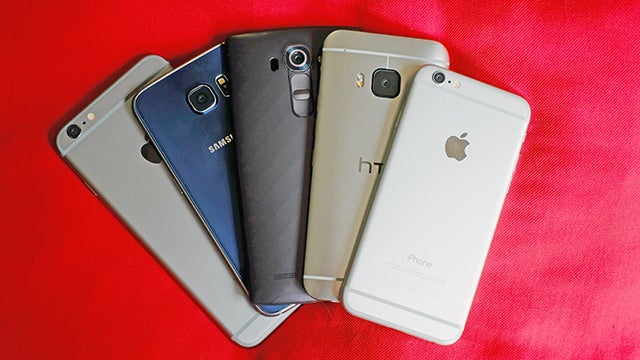
Which top smartphone has the best battery life?
For every phone we review, we perform battery tests. There are benchmarks, and just using the phone to see how long it really lasts in daily use. This combo gives you a good idea of how long any phone will stay awake between charges.
But it’s fallible.
All sorts of things can affect battery life, especially when you’re out and about using the thing. So we decided to get all the big phones of 2015 together and give them a thorough going-over with some real-life-related tests to see which phone really is the longest-lasting.
Which phones? We’ll be checking out the iPhone 6, iPhone 6 Plus, Samsung Galaxy S6, LG G4 and HTC One M9. After all, they’re the most desirable phones of the year.
How we tested smartphone battery life
The whole point of these tests is that we’re getting the phones in the same room, at the same time, so that we can ensure they’re all working under the same conditions.
There are five tests designed to really dig into those things many of you like that really eat away at your battery. First, there’s local video playback. Next up is video streaming.
After that we’ll look at gaming, web browsing and music playback. With all those tests in the bag we can’t fail to find the battery life winners and losers. But first, let’s take a quick look at the hardware.
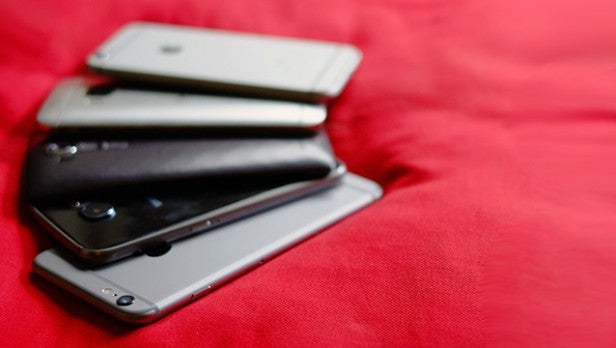
Battery Life Specs Compared
These are all top phones, and all but one follow the usual high-end design trend of not giving you any access to the battery. The iPhone 6, iPhone 6 Plus, Samsung Galaxy S6 and HTC One M9 batteries are all locked in.
Thanks to their unibody designs, you don’t even get to look at the battery unit itself, not to mention replacing the thing should you need to. The LG G4 is the anomaly. Not only can you pull the phone’s plastic battery off, you can take the battery unit itself out and switch it out for a new one. Any headaches of a battery going a bit rubbish after a year vanish instantly.
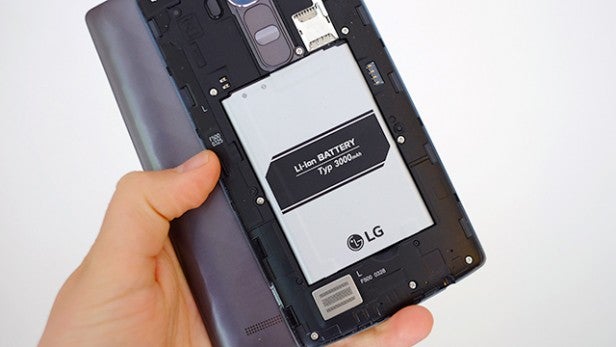
What about capacity? To judge a battery’s capacity you need to look at its amp rating and voltage, but as all smartphones use roughly 3.85V (or thereabouts) batteries, we tend to simply look at their mAh rating. Here’s how they stack up:
Galaxy S6: 2550mAh
LG G4: 3000mAh
HTC One M9: 2840mAh
iPhone 6: 1810mAh
iPhone 6 Plus: 2915mAh
With what we’ve already learned, it seems like the LG G4 is an early candidate for the winner. But as we’ll see, there’s a lot more to real-life performance than pure battery specs. On with the tests…
Test 1: Video
What we did: Six hours of video playback, using the same 720p file
This is the simplest, least strenuous of four display-heavy tests. We simply put a 720p video on the internal storage, and then played it back with Mxplayer on the Android devices and the integrated video player using iPhones. All were played using hardware rendering, meaning the phones weren’t doing unnecessary extra work by decoding the video using software.
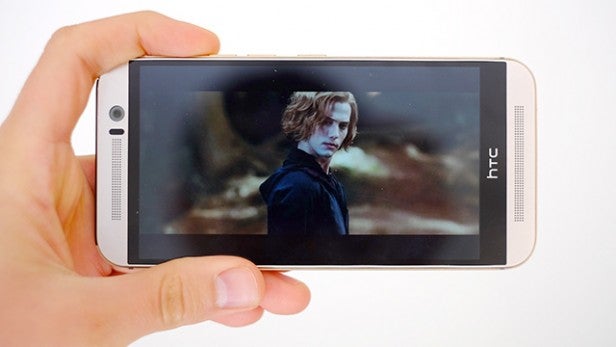
As there’s no simple way to accurately monitor an iPhone’s battery life while running this sort of test, we sat with the phones for six hours, monitoring the battery level at regular intervals. Who says we don’t know how to have fun at TrustedReviews?
Over the five hours, here’s how their stamina dribbled down:
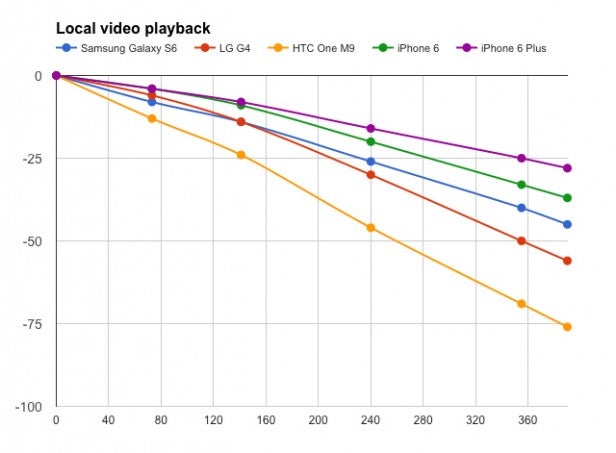

Read those may specs earlier? It’s pretty clear they don’t mean a whole lot. The three clear winners here are the iPhone 6, the Samsung Galaxy S6 and the iPhone 6 Plus, which was a way ahead.
Thanks to needing to sleep we couldn’t sit with the phones overnight as they drained down completely, but we can project how long they last based on our testing.
Galaxy S6: 14.4 hours
LG G4: 11 hours
HTC One M9: 8.5 hours
iPhone 6: 17.5 hours
iPhone 6 Plus: 23 hours
So why are these three so much better? Just feeling the phones after the test finished, it was pretty obvious. The HTC One M9 and LG G4 felt quite warm (particularly the HTC), while the Samsung Galaxy S6 was a fair bit cooler. The iPhones, on the other hand, were cool enough to make you think they had just been sitting around for the last six hours.
We expect Samsung may have put some clever trickery into the software, or perhaps even the workings of the Exynos processor, to improve performance for just this task. And, well, it seems that iOS is still way more efficient generally than Android.
Test 2: Streaming Video
Next up is the slightly more intensive version of our first test. We streamed a video over YouTube using Wi-Fi.
To give it a slightly different style to the local video test, we left the video playing in portrait, thereby taking up a bit less of the screen.
Related: Best Smartphones
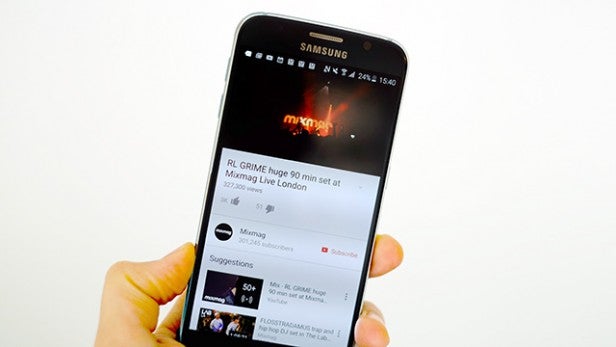
Why not Netflix over 3G/4G? This was a pure practical issue as we didn’t have five identical SIM cards to use. Here’s how the test panned out:
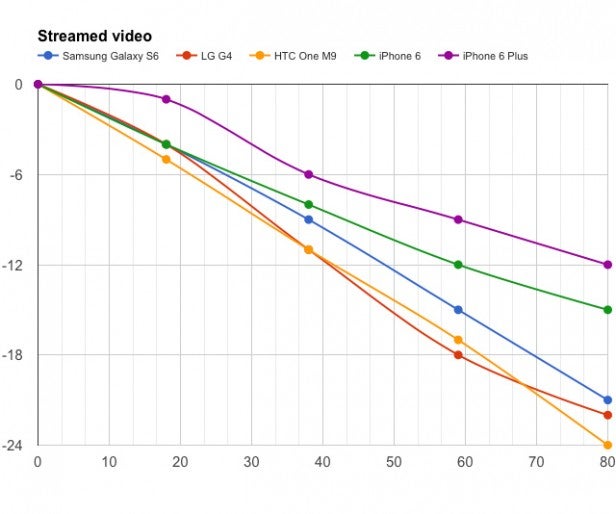

As you can see, the difference between the Galaxy S6 and the other Android phones has flattened out, so that it’s now just one per cent ahead of the LG G4. The HTC One M9 continues to use the most power, and once again it was the hottest at the end of the 80-minute run.
The iPhones maintain a firm lead, though, and that the iPhone 6 Plus uses only half the amount of its reserves as the HTC One M9 is a bit of an eye-opener.
Once again, here’s an extrapolation how how long these phones could last when left streaming video from 100 per cent charge:
Galaxy S6: 6.3 hours
LG G4: 6 hours
HTC One M9: 5.5 hours
iPhone 6: 8.8 hours
iPhone 6 Plus: 11.1 hours
Test 3: Gaming
Cranking things up a notch one more, we come to the gaming test. This an interesting one as it should take some manufacturer optimisation out of the question. As the hardware is pushed that bit closer to the extent of its capability, we start to deal a bit more with the pure efficiency (or lack of) of the components.
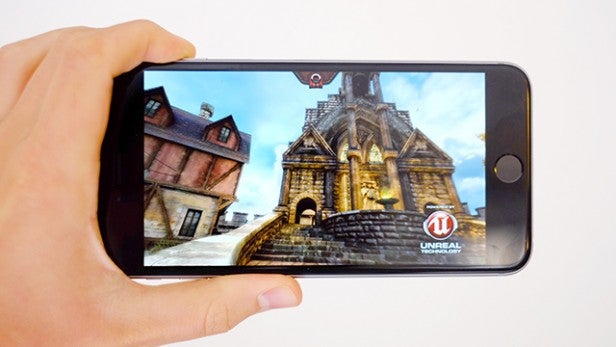
For this test we used the Epic Citadel ‘guided tour’, a graphics demo that uses the Unreal Engine 3 platform. Now, this is a few years old at this point and we’re starting to see mobile projects use the much newer Unreal Engine 4, but it’ll give the GPU a bit more of a workout than the previous tests.
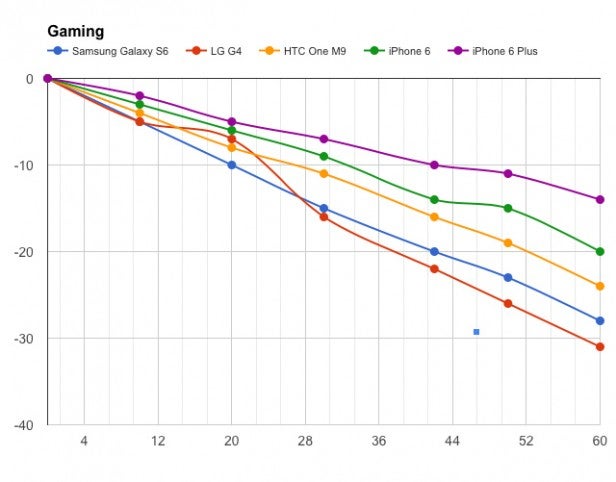

What we find is very interesting, a departure from our other results, at least among the Android devices. From being easily the worst-performing of the phones, the HTC One M9 does the best of all the Androids in this gaming test.
The LG G4 does the worst while the Samsung Galaxy S6 sits somewhere in-between. So, why is this? We can offer some suggestions. First, the HTC One M9 has the lowest resolution of the Androids, using 1080p while the others have QHD screens. We’re not sure whether Epic Citadel actually outputs at QHD resolution (it’s hard to tell in person), but it’s one explanation.
Alternatively, the LG G4 has the weakest processor, meaning it may need to work that bit harder to make Epic Citadel sing.
So why does the Samsung Galaxy S6 lag behind the One M9? Surprisingly, the Samsung had by far the worst frame rate of all the phones, suggesting there’s little-to-no specific GPU optimisation for either Epic Citadel or Unreal Engine 3 (which would be rather more serious). This is slightly alarming when in benchmarks the Samsung Galaxy S6 seems like the most powerful ever made, more-or-less.
It’s one other lesson in the idea that specs aren’t everything.
Once again, the iPhones are way ahead, particularly the frankly amazing iPhone 6 Plus, which uses half the capacity of the fastest-draining Android once again. Impressive, right?
Test 4: Web Browsing
One test we couldn’t do without is browsing. With this one we fired up the browser then used an online utility to reload the TrustedReviews website (the mobile site) every 20 seconds for 150 minutes, once more using the Wi-Fi connection.
The screens were all on the whole time, and set to a similar level of brightness (determined with our very own eyes), which was perhaps just slightly higher than you might use when browsing indoors. One oddity here was that the Samsung Galaxy S6’s screen actually needed to be bumped up a bit, where it had to be lowered in the video test.
This is likely because OLED screens use more power when displaying a white screen, where the power use of LCD is more consistent. Interesting or boring? We’ll leave that to you.
Related: Best Android Phones
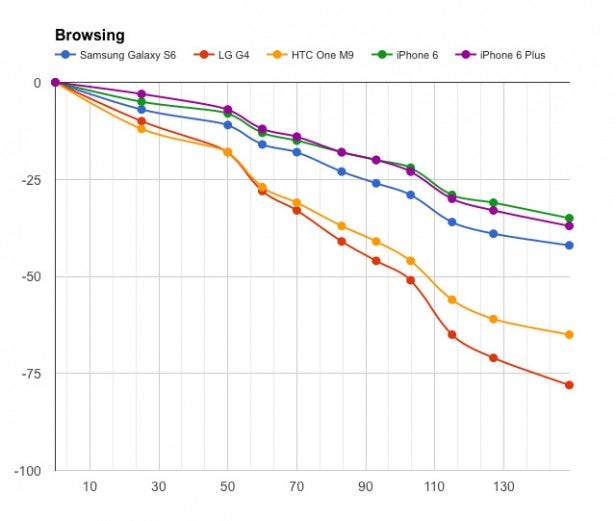
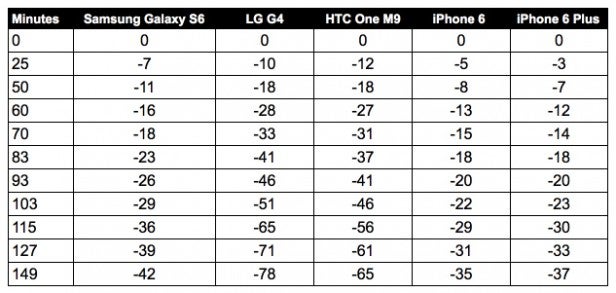
Once again the efficiency of the iPhones and the Galaxy S6 see them leap streets ahead of the other two. The LG G4 is actually the worst performer here, chomping through a whopping 78 per cent of charge over 150 minutes. This is also the one test where the iPhone 6 actually beat the iPhone 6 Plus, if not by a particularly significant margin.
There were some curious unresponsiveness in the website when using the LG G4 and HTC One M9 too, where the others were very smooth — we had to flick on the screen every now and then to make sure the screen didn’t time out, so got to assess performance a bit too.
At the end of the test the LG G4 and HTC One M9 were also a lot hotter than the other phones. The iPhone 6 was the coolest by quite a margin, with the iPhone 6 Plus and Galaxy S6 also getting a bit warm.
Test 5: Music streaming
The last of our tests is a bit different. It’s the only one that doesn’t involve the screen, for the most part.
We set all the phones playing a 2-hour SoundCloud mix through the SoundCloud app, using the internal speaker at 40-per cent volume. This let us check they are all working while turning on the screen as little as possible. And we also got to appreciate the cacophony of five Spanish pop mixes running again each others. Yes, we went with the first long-play SoundCloud mix we found.
Related: Best Cheap Mobile Phones and Budget Smartphones
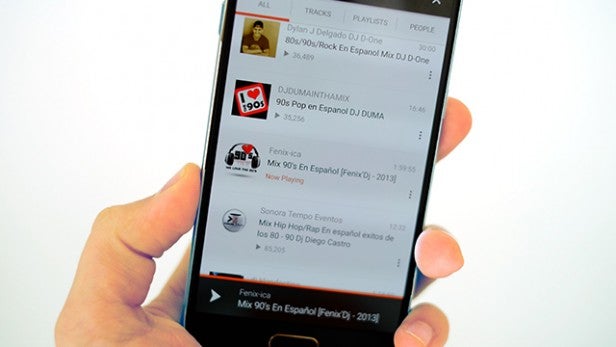
This test sees how low the phones can run while just doing quite low-intensity tasks. But also includes a bit of Wi-Fi downloading so we don’t have to hang around for days.
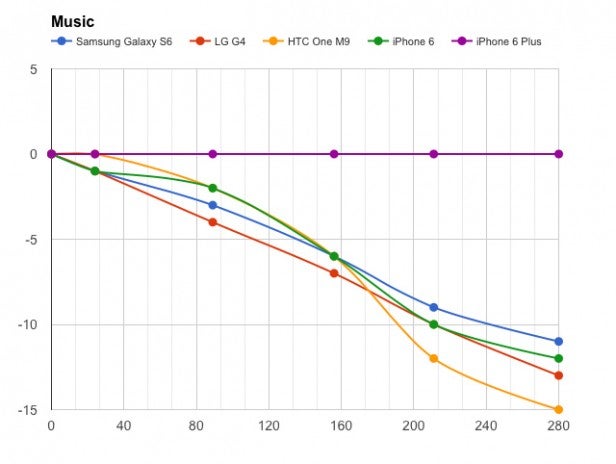

The strange bit here is how much it shows up the iPhone 6 Plus’s bizarre battery reporting. It showed no battery loss across the four hours of music playback, even though a couple of times we headed back into the SoundCloud app to restart the stream, giving it time to re-check-in with the battery level.
Can the iPhone 6 Plus really play music forever off a charge? Not really. We continued the phone’s test after the main run, upping the volume from 40 per cent to 90 per cent (it has a fairly nice speaker by the way) to push it a bit harder and it started losing charge at a rate of a percent every 15-20 minutes. It seemed like the battery reporting had finally caught up with the actual battery level. After a bonus hour it had lost four per cent.
Conclusions
While that last music tests puts some doubts about how the iPhone 6 Plus relays its battery level, it’s clearly the best performer here. The thing lasts for ages.
What’s a little more surprising, perhaps, is how the iPhone 6 actually outlasts the Androids in these consistent use tests. We found that in every single one, the iPhones ended up feeling much cooler than any of the Androids, especially the HTC One M9, suggesting iOS is still way more efficient than Android. And that’s even with the Galaxy S6 offering a super-efficient 14nm processor.
Out of the Androids, the Samsung is the best performer. It only lost out in the gaming test, where its hardware seemed to be poorly optimised for the task, given its strangely low-fps performance in the Epic Citadel demo.
The LG G4 and HTC One M9 sparred for last place, with no clear winner (or loser). Neither is much cop next to the other phones, even though they actually have the highest capacity of all five.
The moral of the story? There’s more to it than just specs.


